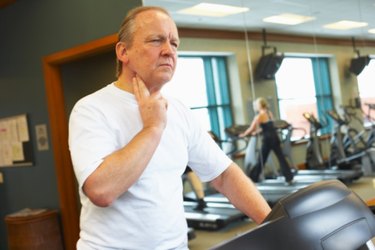
As one of the hardest-working muscles in the body, your heart beats thanks to a complex system of nerves, cells, biochemicals and minerals. Acetylcholine, a biochemical, plays a large role in maintaining your heart's rhythm when you are at rest. It is part of the cascade of processes that influence your heart's natural pacemaker.
Heart Information
Video of the Day
Your heart is a strong muscle, a little bigger than your fist. The American Heart Association states that, during the day, the average heart beats 100,000 times and pumps about 2,000 gallons of blood. Your heart has four chambers -- two atriums and two ventricles -- that open and close in a specific rhythm, which is controlled by electrical impulses. According to the American Heart Association, heart chambers contract when an electrical impulse moves across them. This movement triggers the sinoatrial node, or the "pacemaker," to send out impulses, which in turn cause your heart to beat. Typically, your built-in pacemaker generates impulses at a steady rate; however, emotions, actions and hormonal factors can cause your heart to vary in rhythm.
Video of the Day
Acetylcholine
Acetylcholine, or ACh, is a neurotransmitter used by nerve cells that control your heart, muscles and lungs. According to Eastern Kentucky University, it is also used by neurons in the brain involved in memory functions. ACh is made from acetyl coenzyme A, through a process faciliated by the enzyme choline acetyltransferase. According to the University of Washington, ACh is released at the junction between nerve and muscle cells, called the motor end-plate. This release signals calcium ions to begin muscle contraction.
Heart Innervation
According to Cvphysiology.com, the heart receives its electrical impulses via the vagus nerve and sympathetic nervous system fibers. The right vagal nerve primarily innervates the sinoatrial node, which is under parasympathetic nervous system control. The parasympathetic nervous system governs "at rest" behavior, like digestion, whereas the sympathetic nervous system is your body's stress response. In other words, the sympathetic response leads to a racing heart, while the parasympathetic maintains your body at rest.
Acetylcholine Release
It is parasympathetic and vagus nerve activation that releases acetylcholine onto your sinoatrial node, states Cvphysiology.com. This action decreases pacemaker rate by increasing potassium and decreasing calcium and sodium movement. As the pacemaker slows, so does your heart rate. At rest, the acetylcholine released by the vagus nerve can bring your heart rate down to 60 to 80 beats per minute.
Acetylcholine Inhibition
An increase in heart rate requires an inhibition of vagus nerve stimulation or acetylcholine activity. According to Cvphysiology.com, in experiments where the right vagus nerve is removed, the sinoatrial node firing rate increases if the resting heart rate was below 100 beats per minute. To increase heart rate, your body will increase the sympathetic nervous system stimulation; this process inhibits the vagus nerve's action -- i.e., acetylcholine release. Acetylcholine's action must be overcome in order to speed up heart rate. Your body will also increase sympathetic outflow to the sinoatrial node, which releases norepinephrine, an excitatory neurotransmitter that increases heart rate.